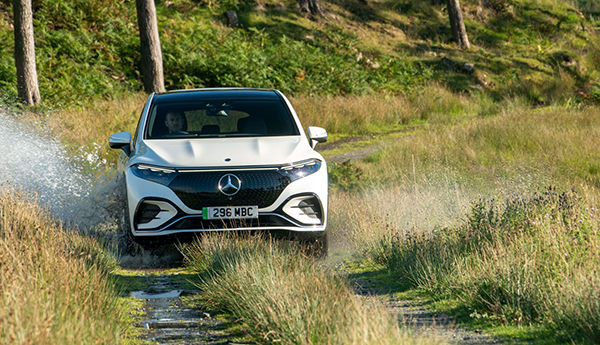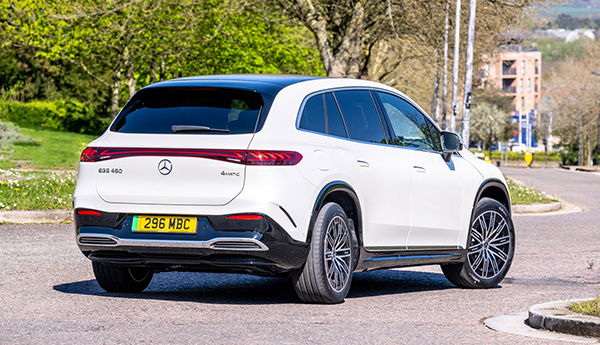You’re looking at the massive electric flagship of the electric Mercedes EQ range; the EQS SUV. As the name suggests, it’s a larger, taller version of the already massive EQS saloon, and promises to pack all the luxury of the ICE-powered Sonderklasse in a larger, battery-electric SUV body.

Sometimes, though, going bigger and bolder doesn’t always work. Mercedes’ own S-Class has been a flagship because it’s also remained relatively restrained despite always being armed to the teeth with genuinely innovative new technologies. We’ve driven the EQS 450 on UK roads to figure out where it places itself, and whether it is a real flagship.
Tell me about the EQS SUV’s specs and performance first
There are two power variants available in the UK: 450 and 580. Both have the same size battery (108.4kWh) and both have dual motor set-ups for all-wheel drive. In fact, Mercedes claims there’s only about a mile difference in the two variant’s ranges: up to 364 miles for the 450; up to 363 miles for the 580. On top of that, both EQS models feature air suspension and rear-wheel steer with 10º of rear-steer angle available to help with manoeuvrability.
So, your choice is only really about performance; the 450 develops 355bhp and 590lb ft from its two motors, and sprints to 62mph in six seconds. The 580, meanwhile, develops 536bhp and 633lb ft and takes just 4.6 seconds to sprint to 62mph if you ask it nicely. Both top out at 130mph.
Then your other choice is the trim: AMG Line Premium Plus or Business Class. The former is already brimming with technology and kit: 21-inch wheels, acoustic glass, a large portrait central screen with biometric technology, a Burmester 3D audio system (which is really good) as well as heated/cooled/memory seats are all standard. The only option you really could tick is the addition of the Hyperscreen infotainment system – but it’s something we recommend you avoid.

The Business Class prioritises the rear passengers more with Merc’s Rear Seat Comfort pack among other luxuries, and the brand’s wild Hyperscreen setup is included as standard. All EQS SUV models are seven seats in the UK market.
Suitably flashy and tech filled, then – but how does the EQS SUV drive?
Let’s start with the good. Naturally, given the enormity of the EQS SUV’s battery, the range figure is deeply impressive and does feel technically possible to achieve. Our tests on UK roads in winter were still projecting circa-300 miles of usable range, for example, and the EQS has reasonably good (if not class-leading) charging speeds of up to 200kW charging speeds, meaning you won’t be waiting an age for that enormous battery to fill on high-power public points.
The next good point is refinement. The EQS SUV has one of the better-screwed-together interiors from Mercedes of late, after years of creaky and plasticky cockpits that have made us wince from the Three-Pointed Star. What also helps that is the Acoustic Comfort package that’s standard on EQS SUV models; Mercedes says sound-suppressing glass, reinforced soft materials and extra insulation over other cars in the range help quell road and wind noise and it really does work on the road – at any speed and in any weather, the EQS SUV is remarkably quiet.
But, elsewhere, the EQS SUV’s dynamic properties are poor at best. The steering is overly light and doesn’t always feel like it relaxes at higher speeds, for example, and the rear-wheel steering takes a very long time to get used to. It’s advantageous when it comes to parking but, couple it with the light steering rack and it makes the car feel unpredictable and twitchy at lower speeds.

Performance is nothing special, which is largely derived from the EQS SUV’s immense weight (2.8 tonnes!) and that hulking weight doesn’t help the brakes either; particularly under hard presses they feel weak, which won’t inspire you with confidence. But when you’re not hard charging towards roundabouts or out on a country road jaunt, the brake pedal in general is one of the least consistent I’ve tried in recent memory; there’s about an inch of next-to-no brake pressure, then it’s like you’re standing on an over-inflated football causing jerkiness when the brakes are applied. In short, it’s next to impossible to find a cohesive and consistent braking strategy with your feet.
And then there’s the air suspension. I’ve already criticised the EQE SUV for feeling a little blobby and wobbly but this larger EQS SUV takes that to a whole new level. If there’s a big undulation in the road, the EQS SUV pitches and wallows and flops around for what feels like far too long, remaining unsettled for some time on uneven roads. And yet, conversely, the large wheels mean it crashes over lumpy potholes on (increasingly) crappy UK roads. Even if the EQS SUV is not designed as a car to hustle around, a little more dynamic neutrality would massively improve the drive. Just look at the S-Class as a prime example of this: the ride still manages to be cushy and plump and well-resolved without making you feel car sick while at the wheel.
Anything else worth mentioning?
Given its size, space inside the EQS SUV. The second row, for example, feels equally palatial as sitting up front, and the boot volume is naturally impressive, too. The trade-off is that Mercedes seems to have done very little to make the EQS SUV feel smaller than it is; this thing is W I D E on UK roads, and I’ve had passengers note that the car feels heavy to them – despite not being the one driving it.
The brand’s MBUX infotainment system, meanwhile, is fine to use but I’d like to posit the theory that it gets fiddlier the larger the car is. Keeping such a large car with such floppy suspension on the straight-and-narrow while attempting to tap a large screen doesn’t tend to produce the result you want.

Mercedes EQS: verdict
Despite Mercedes’ efforts to create a properly luxurious electric flagship in only a way the brand can, the resulting EQS SUV has considerably missed the mark expected from a premium car brand.
Its enormous price tag launches it into the stratosphere when it comes to expectation from the off, and Mercedes valiantly fights to make relevant by offering such a huge usable range and a quiet cabin that’s brimming with luxuries without needing to spend extra. But it doesn’t feel quite enough to feel like good value.
Especially when, dynamically, the EQS SUV is entirely undercooked. Twitchy and numb steering, deeply inconsistent and weak brakes, lacklustre performance and a suspension system that feels so lacking in damping and control that the impressive high-speed refinement is completely eliminated in almost any other scenario. The EQS is not an enjoyable car to drive.
That doesn’t mean Mercedes isn’t capable of making some good electric (or, at least, electrified) cars. If you’re not bothered about having seven seats, the EQE SUV feels just as premium inside, handles a little better and has 90 per cent of the technology this has for about £40k less. And don’t forget the current-shape S-Class, either – it’s still a beacon of refinement and luxury, and the plug-in hybrid offers 70+ miles of e-range, too.
2024 Mercedes-Benz EQS SUV Missing The Mark
19/12/2023
No Comments
Mercedes-Benz | Mercedes-AMG
Click to rate this post
[Total: 1 Average: 5]